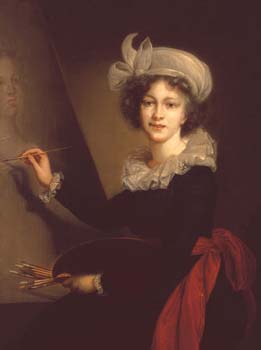Self-portrait
- n.d., after 1790 painting
- After Marie-Louise-Elisabeth Vigée-Le Brun (French 1755-1842)
- Oil on linen
58.8 x 42.8 cm., 23 x 16-7/8"
- Catherine Carter Goebel, Paul A. Anderson Chair in the Arts Purchase, Paul A. Anderson Art History Collection, Augustana College 2004.11

Essay by Jennifer Johnson, Class of 2006
This painting, done with oils on linen, is a nineteenth-century copy of Vigée-Le Brun's original Self-portrait created in 1790. Copies of the Old Masters were often painted by students and followers in order to improve techniques and teach subtleties in application. The fact that this piece was copied in the nineteenth century provides evidence that this painter was greatly respected by subsequent generations.
This self-portrait reveals Vigée-Lebrun's mature painting style, with its almost invisible brushstrokes and fine academic finish. It seems to capture a moment as the artist, in the middle of painting Marie-Antoinette's image, turns to pose for her own portrait. The subject of her canvas, the queen of France, reinforces the painter's important status. The almost monochromatic background is interrupted only by the faint outline of a canvas and the face of Marie-Antoinette, but essentially serves as a backdrop for the main subject. Vigée-LeBrun's face appears flawless and her eyes reflect an engaged intellect. It is this perfect, finished expression that led many critics to unfairly call her portraits "vacuous" (Opfell 42). The artist's use of black and white with a touch of red, as well as the sophisticated play of light and shadow, lends the painting drama and purpose, reflecting her own independent nature and never-ending drive to succeed.
As with many successful portrait painters, Vigée-Le Brun was known to flatter her subjects, even herself, when she painted. In this image, she would have been thirty-five years old, but painted herself looking much younger, possibly in her twenties. Her clothing is simple and unembellished. She did not wear the elaborate styles of dress, hair and makeup in vogue at the time, but insisted on simple gowns without lavish makeup or wigs. She also often wore a turban on her head, as seen in this painting. In addition to her not being bound by fashion, she often insisted that her subjects also not wear fashionable makeup and wigs (Opfell 41). She likely wanted to get at the heart of the person and not allow props to overshadow the personality.
